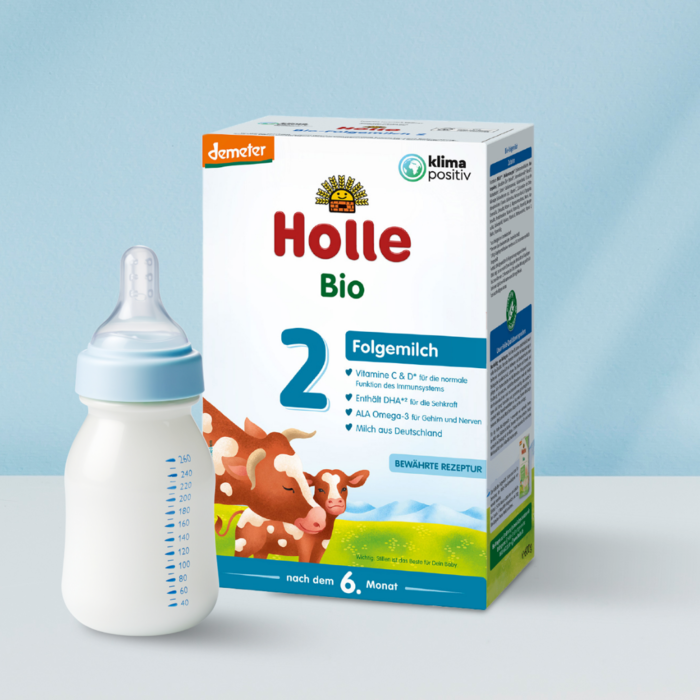FOLLOW-ON FORMULA (6-10 MONTHS)
Guiding developmental milestones with precision, our Organic Follow-On Formulas Stage 2 are meticulously formulated for ages six to ten months. While maintaining a nutritional profile akin to Stage 1, Stage 2 is notably more calorie-dense, furnishing heightened energy for your exploring and engaging infant. Rest assured, each Stage 2 formula undergoes rigorous testing, securing official certifications, and is meticulously crafted to cater to the needs of your growing, active baby. Unveil the keys to harmonious breastfeeding and formula feeding, ensuring a thriving and contented baby, all detailed in our comprehensive guide for discerning parents.9 products
-
Jovie Stage 2 Organic Goat Milk Formula

 Vendor:Jovie Stage 2 Organic Goat Milk FormulaOrganic Formula
Vendor:Jovie Stage 2 Organic Goat Milk FormulaOrganic Formula- Regular price
-
From
$64.87 - Regular price
-
$79.99 - Sale price
-
From
$64.87
Quick view
-
HiPP Dutch Combiotic Infant Formula 2

 Vendor:HiPP Dutch Combiotic Infant Formula 2HiPP
Vendor:HiPP Dutch Combiotic Infant Formula 2HiPP- Regular price
-
From
$49.99 - Regular price
-
$54.99 - Sale price
-
From
$49.99
Quick view
-
Holle Organic Infant Formula 2

 Vendor:Holle Organic Infant Formula 2Holle
Vendor:Holle Organic Infant Formula 2Holle- Regular price
-
From
$33.99 - Regular price
-
$39.99 - Sale price
-
From
$33.99
Quick view
-
Holle Organic Infant GOAT Milk Formula 2

 Vendor:Holle Organic Infant GOAT Milk Formula 2Holle
Vendor:Holle Organic Infant GOAT Milk Formula 2Holle- Regular price
-
From
$33.99 - Regular price
-
$39.99 - Sale price
-
From
$33.99
Quick view
-
HiPP Combiotic Infant Formula 2

 Vendor:HiPP Combiotic Infant Formula 2HiPP
Vendor:HiPP Combiotic Infant Formula 2HiPP- Regular price
-
From
$41.99 - Regular price
-
$47.99 - Sale price
-
From
$41.99
Quick view
-
HiPP Hypoallergenic (HA) Infant Formula 2

 Vendor:HiPP Hypoallergenic (HA) Infant Formula 2HiPP
Vendor:HiPP Hypoallergenic (HA) Infant Formula 2HiPP- Regular price
-
From
$41.99 - Regular price
-
$47.99 - Sale price
-
From
$41.99
Quick view
-
Lebenswert Organic Infant Formula Stage 2

 Vendor:Lebenswert Organic Infant Formula Stage 2Lebenswert
Vendor:Lebenswert Organic Infant Formula Stage 2Lebenswert- Regular price
-
From
$28.99 - Regular price
-
$36.99 - Sale price
-
From
$28.99
Quick view
-
HiPP Anti-Reflux Special Milk Formula - All Stages

 Vendor:HiPP Anti-Reflux Special Milk Formula - All StagesHiPP
Vendor:HiPP Anti-Reflux Special Milk Formula - All StagesHiPP- Regular price
-
From
$41.99 - Regular price
-
$47.99 - Sale price
-
From
$41.99
Quick view
-
HiPP Comfort Special Milk Formula - All Stages

 Vendor:HiPP Comfort Special Milk Formula - All StagesHiPP
Vendor:HiPP Comfort Special Milk Formula - All StagesHiPP- Regular price
-
From
$41.99 - Regular price
-
$47.99 - Sale price
-
From
$41.99
Quick view
Why Parents Trust Us
Balancing Breastfeeding and Formula Feeding: A Guide to Successful Combo Feeding
The arrival of a new family member is a momentous occasion filled with joy and excitement, but it also ushers in a series of decisions and challenges for new parents. Among these, the choice between exclusive breastfeeding and formula feeding is a common concern. However, there exists a third option that combines the merits of both approaches: combo feeding. In this article, we explore the nuances of combo feeding, its benefits, potential challenges, and practical strategies for a successful combo feeding journey for your little one.
The Advantages of Combo Feeding
The blend of breastfeeding and formula feeding brings several advantages for both infants and parents. Here's a closer look at what this approach can offer:
-
Flexibility and Convenience: Introducing formula feeding into your baby's routine grants you flexibility and convenience. Combo feeding allows you to share feeding duties with your partner or other caregivers, affording you more time and freedom to address other life demands.
-
Enhanced Nutritional Intake: Combo feeding ensures that your baby receives the vital nutrients present in breast milk while supplementing their diet with the necessary components found in formula. This balanced approach can support your baby's growth and development, providing a well-rounded nutritional intake.
-
Extended Breastfeeding Duration: For some mothers, maintaining exclusive breastfeeding can be physically taxing and challenging to sustain over an extended period. Combo feeding enables you to continue breastfeeding while gradually incorporating formula feeding, extending the duration of breastfeeding as desired.
-
Improved Sleep for Parents: A significant advantage of combo feeding is the potential for better sleep for parents. Sharing nighttime feedings with a partner or using formula feeding during the night can ease the burden on one person, allowing both parents to get much-needed rest.
Getting Started with Combo Feeding
Before embarking on the combo feeding journey, it's essential to plan and become familiar with the necessary steps. Here are some guidelines to initiate a successful combo feeding routine:
-
Consult with a Healthcare Professional: Seek guidance from your healthcare provider or a lactation consultant before commencing combo feeding. They can offer personalized advice based on your baby's specific needs and your unique circumstances, ensuring a smooth transition.
-
Establish a Breastfeeding Routine: To maintain a healthy milk supply, create a consistent breastfeeding routine. Breastfeed your baby on demand or at regular intervals, aligning with their feeding cues. This routine aids in sustaining your milk supply as you introduce formula feeding.
-
Gradual Introduction of Formula: When introducing formula, start with one bottle per day and incrementally increase the number of formula feedings over time. This gradual approach enables your baby to adapt to the new feeding method while minimizing potential digestive issues.
-
Select the Right Formula: Choosing the suitable formula for your baby is paramount. Consult with your healthcare provider to determine the most appropriate formula based on your baby's nutritional requirements, allergies, or other specific needs.
-
Maintain Skin-to-Skin Contact: Even with the inclusion of formula feeding, retaining skin-to-skin contact with your baby during breastfeeding sessions remains essential. This bonding time fosters a sense of closeness and strengthens the breastfeeding relationship.
In Conclusion
Combo feeding presents a flexible and pragmatic approach to nourishing your baby. By combining breastfeeding and formula feeding, you can enjoy the advantages of both methods while crafting a feeding routine that suits your family's needs. Remember to seek guidance from healthcare professionals, establish a routine, introduce formula gradually, and prioritize bonding with your little one throughout the process. With the right information and support, you can navigate the realm of combo feeding successfully and provide your baby with the nourishment they require.
Are You Still Feeling a little Unsure?
No worries! We know, a parent's formula-feeding journey is personal, unique, and sometimes challenging. We at Organic Formula are proud to have a team that can help guide you along the way.
To provide a stellar customer experience, the entire support team members are experts in Infant Nutrition: from Breastfeeding and Bottle feeding to Baby's first solids and so much more!





















